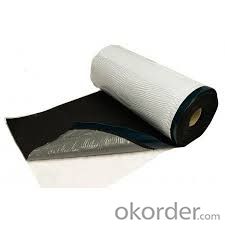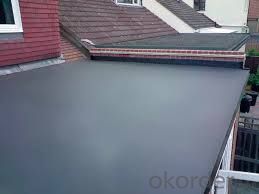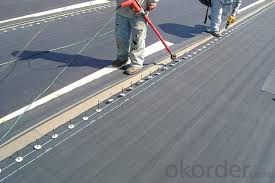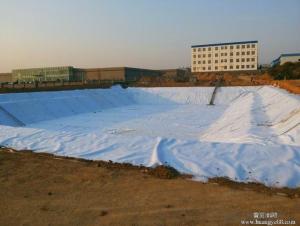1.0mm 1.2mm 1.5mm 1.8mm 2.0mm EPDM Waterproof Membrane For Your Reference
- Loading Port:
- Shanghai
- Payment Terms:
- TT OR LC
- Min Order Qty:
- 1000 m²
- Supply Capability:
- 200000 m²/month
OKorder Service Pledge
OKorder Financial Service
You Might Also Like
Product description
EPDM is a world-recognised popular waterproofing material in the recent thirty years. Hongyuan adopts the world−advanced equipment of cold feeding extrusion and continuous vulcanization technology. With the best performance among high polymer waterproof materials, EPDM is of exceptional elasticity and will not split or crack under normal building movement.
Application Scope
Waterproofing, anti-seepage and moisture proof of side walls of basements, baseboards, head plates and roofs.
Advantagee
1.Excellent anti aging performance ,service life up to 50 years.
2.High extension rate,high tensile strength ,small size changes at heat treatment.
3.Good plant roots penetrability resistance and can be made waterproofing layer of planting roof.
4.Special modified molecular structure ,effectively resolving the current domestic and foreign glue joint problem.
5.Good low temperature flexibility ,and good performance of adapting to ambient temperature changes.
6.Convenient application ,solid joint ,no environment pollution.
7.Chemical corrosion resistance ,can be used for special occasions.
8.Good anti-perforated.
Storage:
Different types or specifications of products should be separated, not mixed.
Keep it dry and ventilated, protected from the sun or rain.
Storage temperature should never be higher than 45 °C. Pile up the membranes flatwise whose stockpile height never exceeds five layers. One layer is guaranteed if it is placed vertically.
Prevent it from inclination or In the process of transportation, it should be lying in case of inclination or lateral pressure. If necessary, cover it with felt-cloth.
Storage time is at least one year from manufacture date on if the product is under normal operation of storage.
Advantages
Technical Parameters
Item | Index | ||||||
1 | Thickness of resin layer of the middle fabric ,mm≥ | - | - | 0.40 | 0.40 | 0.40 | |
2 | Tensile performance | Max tensile strength,N/cm ≥ | - | 120 | 250 | - | 120 |
Tensile strength,NPa ≥ | 10 | - | -10 | - | - | ||
Max elongation% ≥ | - | - | 15 | - | - | ||
Breaking elongation % ≥ | 200 | 150 | - | 200 | 100 | ||
3 | Heat treatment size change rate%≤ | 2.0 | 1.0 | 0.5 | 0.1 | 0.1 | |
4 | Cold bonding | -25°c No cracks | |||||
5 | Watertightness | 0.3mPa,2h waterproof | |||||
product show















FAQ
Q: What's the de6abf1fe186f8d58506cbcfe46eed814d.jpglivery time ?
A: 3-5 days for 1-600 rolls, 10-15 days for container.
Q: What's the payment terms ?
A: TT/LC
Q: How do you make replacement with quality problems ?
A: New replacement will be packed into your next order or send to you directly after receive video or photo about quality problems.
- Q: Can a waterproofing membrane be used in conjunction with soundproofing materials?
- Using waterproofing membranes in conjunction with soundproofing materials is a common practice in construction projects. Waterproofing membranes are typically employed to prevent water from entering a structure, while soundproofing materials are used to minimize noise transmission. Although these materials serve different purposes, they can be utilized simultaneously to achieve both waterproofing and soundproofing advantages. For instance, in buildings with basements or bathrooms, waterproofing membranes can be installed on the walls or floors to prevent water infiltration. Subsequently, soundproofing materials can be added on top of the membranes to reduce noise transmission from adjacent areas. By combining these two materials, a building can be safeguarded against water damage while also providing a quieter and more comfortable environment for its occupants.
- Q: Does a waterproofing membrane require any curing time before it can be exposed to water?
- Before being exposed to water, a waterproofing membrane does require a curing time. This curing time is necessary for the membrane to fully bond and reach its maximum strength, durability, and waterproofing capabilities. The specific duration of the curing time may vary depending on the type of membrane and the instructions provided by the manufacturer. To ensure proper curing and effective protection against water intrusion, it is crucial to adhere to these instructions. Neglecting to allow sufficient curing time can compromise the membrane's effectiveness, potentially resulting in leaks or other related issues. Therefore, it is highly recommended to wait until the specified curing time has passed before exposing the waterproofing membrane to water.
- Q: Can a waterproofing membrane be used in elevator pits or sump pits?
- Yes, a waterproofing membrane can be used in elevator pits or sump pits. Elevator pits and sump pits are prone to water infiltration, and a waterproofing membrane can effectively prevent water from seeping into these areas. The membrane acts as a barrier, preventing any water from entering the pit and causing damage to the elevator or pumping system. This helps to maintain the integrity of the elevator or pump and prolong its lifespan. Additionally, a waterproofing membrane can also protect the surrounding structures and prevent any water damage. It is important to select a suitable waterproofing membrane that is designed for below-ground applications and has the necessary properties to withstand the specific conditions in an elevator or sump pit.
- Q: Is a waterproofing membrane resistant to impact damage?
- A waterproofing membrane is generally not designed to be resistant to impact damage. Its primary function is to prevent water infiltration and protect the underlying structure from moisture damage. While some membranes may have a certain level of impact resistance, it is not their main characteristic. To protect the membrane from impact damage, additional measures like installing protective layers or using impact-resistant materials may be necessary.
- Q: What materials are commonly used for waterproofing membranes?
- Different materials are commonly used for waterproofing membranes, each having their own unique properties and advantages. Some of the most frequently used materials are as follows: 1. Bitumen: Due to its exceptional waterproofing properties, bitumen is a popular option for waterproofing membranes. It is a sticky, black, and viscous substance derived from petroleum. Often, it is blended with polymers to increase its flexibility, durability, and resistance to UV radiation. 2. PVC (Polyvinyl Chloride): PVC membranes are extremely durable and resistant to chemicals, making them suitable for a variety of waterproofing applications. They are easy to install and can withstand extreme temperatures, making them a preferred choice for flat roofs and underground structures. 3. EPDM (Ethylene Propylene Diene Monomer): EPDM is a synthetic rubber membrane that is highly flexible and durable. It can withstand UV radiation, ozone, and extreme temperatures, making it suitable for both above and below-ground applications. EPDM membranes are commonly used for roofs, foundations, and pond liners. 4. TPO (Thermoplastic Olefin): TPO membranes are a combination of rubber and plastic polymers, making them highly flexible, durable, and resistant to UV radiation. They are lightweight and easy to install, making them popular for commercial roofing applications. 5. HDPE (High-Density Polyethylene): HDPE membranes are manufactured from high-density polyethylene and are known for their excellent resistance to chemicals. They are commonly employed for waterproofing underground structures, such as tunnels and basements. 6. Bentonite: Bentonite clay is a natural material that expands when it comes into contact with water, creating a gel-like substance that seals cracks and pores. Bentonite membranes are frequently utilized for waterproofing below-ground structures and are highly effective in preventing water infiltration. 7. Liquid applied membranes: These membranes are typically composed of a combination of synthetic polymers and rubber. They are applied as a liquid and, once cured, form a continuous, seamless, and flexible waterproofing layer. Liquid applied membranes are versatile and can be used for various applications, including roofs, balconies, and foundations. It is important to note that the choice of material depends on the specific requirements of the project, including the type of structure, environmental conditions, and budget. Consulting with a waterproofing professional is recommended to determine the most suitable material for a particular application.
- Q: Can a waterproofing membrane be used on tunnels with architectural features?
- Yes, a waterproofing membrane can be used on tunnels with architectural features. The membrane can be applied to various surfaces, including those with architectural features, to provide effective waterproofing and prevent water infiltration. This ensures the protection of the tunnel structure and helps maintain its integrity.
- Q: Can a waterproofing membrane improve energy efficiency?
- Yes, a waterproofing membrane can improve energy efficiency. A waterproofing membrane acts as a barrier against moisture intrusion, preventing water from seeping into the building envelope. By keeping the structure dry, it helps to prevent the growth of mold and mildew, which can contribute to poor indoor air quality and the deterioration of building materials. In addition to protecting against moisture, a waterproofing membrane can also provide insulation benefits. Many waterproofing membranes are designed to have a high thermal resistance, or R-value. This means that they can provide an extra layer of insulation to the building, reducing heat transfer through the walls or roof. By improving the building's thermal performance, a waterproofing membrane can help to reduce the load on heating and cooling systems, resulting in energy savings and improved energy efficiency. Furthermore, a waterproofing membrane can also help to reduce air leakage in a building. Air leakage can account for a significant amount of energy loss, as conditioned air escapes through gaps and cracks in the building envelope. By sealing off these areas, a waterproofing membrane can help to improve the building's air tightness, reducing energy loss and improving energy efficiency. Overall, a waterproofing membrane can play a crucial role in improving energy efficiency by preventing moisture intrusion, providing additional insulation, and reducing air leakage. Investing in a high-quality waterproofing system can lead to long-term energy savings, improved indoor comfort, and a more sustainable and efficient building.
- Q: What is the difference between a self-adhesive and torch-applied waterproofing membrane?
- A self-adhesive waterproofing membrane is a type of membrane that has an adhesive backing, allowing it to be easily stuck onto the surface it is being applied to. It is typically made of a flexible material, such as modified bitumen or rubberized asphalt, and is commonly used for applications such as roofs, balconies, or foundations. The adhesive backing ensures a strong and secure bond, even in challenging weather conditions. On the other hand, a torch-applied waterproofing membrane requires the use of a torch or heat gun to melt the underside of the membrane and adhere it to the surface. This type of membrane is often made of modified bitumen, which softens and becomes adhesive when heated. The heat creates a strong bond between the membrane and the substrate, providing excellent waterproofing protection. The main difference between these two types of waterproofing membranes lies in the way they are installed. Self-adhesive membranes offer a simpler and quicker installation process, as they can be directly applied to the surface without the need for any additional tools or equipment. They are also considered to be a safer option, as they eliminate the potential hazards associated with using an open flame. Torch-applied membranes, on the other hand, require the use of a torch or heat gun, which adds an extra step to the installation process. This method requires skilled labor and proper training to ensure the membrane is correctly melted and adhered to the surface. However, torch-applied membranes are often preferred in situations where a superior bond is required, such as on roofs with a steep slope or in areas with heavy foot traffic. In summary, the main difference between self-adhesive and torch-applied waterproofing membranes lies in the method of installation. Self-adhesive membranes offer simplicity and safety, while torch-applied membranes provide a stronger bond and are often used in more challenging or specific applications. The choice between the two ultimately depends on the specific requirements and conditions of the project.
- Q: Can a waterproofing membrane be used for a shower enclosure?
- Yes, a waterproofing membrane can be used for a shower enclosure. Waterproofing membranes are designed to prevent water from seeping through surfaces and causing damage. In a shower enclosure, where water exposure is high, a waterproofing membrane can be applied to the walls and floor to create a protective barrier. This helps to ensure that water does not penetrate the surrounding structure, preventing issues such as mold, rot, and water damage. It is important to choose a waterproofing membrane specifically designed for showers and follow the manufacturer's instructions for proper installation to ensure the best results.
- Q: Can waterproof sheets be used on steel roof panels?
- The main products are asphalt waterproofing membrane and polymer waterproofing membrane.
Send your message to us
1.0mm 1.2mm 1.5mm 1.8mm 2.0mm EPDM Waterproof Membrane For Your Reference
- Loading Port:
- Shanghai
- Payment Terms:
- TT OR LC
- Min Order Qty:
- 1000 m²
- Supply Capability:
- 200000 m²/month
OKorder Service Pledge
OKorder Financial Service
Similar products
Hot products
Hot Searches
Related keywords
































